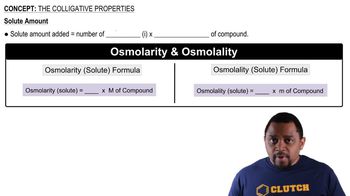A 1.2 m aqueous solution of an ionic compound with the formula MX2 has a boiling point of 101.4 °C. Calculate the van't Hoff factor (i) for MX2 at this concentration.
Ch.14 - Solutions
Chapter 14, Problem 103
Calculate the vapor pressure at 25 °C of an aqueous solution that is 5.50% NaCl by mass. (Assume complete dissociation of the solute.)
 Verified step by step guidance
Verified step by step guidance1
Determine the mass of NaCl and water in the solution. Assume a 100 g solution, which means 5.50 g of NaCl and 94.50 g of water.
Calculate the moles of NaCl using its molar mass (NaCl = 58.44 g/mol).
Since NaCl dissociates completely into Na⁺ and Cl⁻ ions, calculate the total moles of particles in the solution.
Calculate the mole fraction of water (solvent) using the formula: \( \text{mole fraction of water} = \frac{\text{moles of water}}{\text{moles of water} + \text{moles of NaCl particles}} \).
Use Raoult's Law to find the vapor pressure of the solution: \( P_{\text{solution}} = \chi_{\text{water}} \times P^0_{\text{water}} \), where \( P^0_{\text{water}} \) is the vapor pressure of pure water at 25 °C.

Verified video answer for a similar problem:
This video solution was recommended by our tutors as helpful for the problem above.
Video duration:
5mWas this helpful?
Key Concepts
Here are the essential concepts you must grasp in order to answer the question correctly.
Vapor Pressure
Vapor pressure is the pressure exerted by a vapor in equilibrium with its liquid or solid phase at a given temperature. It reflects the tendency of particles to escape from the liquid phase into the vapor phase. The vapor pressure of a solution is typically lower than that of the pure solvent due to the presence of solute particles, which disrupt the solvent's ability to evaporate.
Recommended video:
Guided course

Raoult's Law and Vapor Pressure
Colligative Properties
Colligative properties are properties of solutions that depend on the number of solute particles in a given amount of solvent, rather than the identity of the solute. These properties include vapor pressure lowering, boiling point elevation, freezing point depression, and osmotic pressure. In this case, the presence of NaCl will lower the vapor pressure of the aqueous solution compared to pure water.
Recommended video:
Guided course

Colligative Properties
Dissociation of Ionic Compounds
When ionic compounds like NaCl dissolve in water, they dissociate into their constituent ions (Na⁺ and Cl⁻). This complete dissociation increases the total number of solute particles in the solution, which is crucial for calculating the colligative properties. For a 5.50% NaCl solution, the effective concentration of solute particles is doubled due to this dissociation, impacting the vapor pressure significantly.
Recommended video:
Guided course

Ionic Compounds Naming
Related Practice
Textbook Question
Textbook Question
A 0.100 M ionic solution has an osmotic pressure of 8.3 atm at 25 °C. Calculate the van't Hoff factor (i) for this solution.
Textbook Question
An aqueous CaCl2 solution has a vapor pressure of 81.6 mmHg at 50 °C. The vapor pressure of pure water at this temperature is 92.6 mmHg. What is the concentration of CaCl2 in mass percent? (Assume complete dissociation of the solute.)
Textbook Question
The solubility of carbon tetrachloride (CCl4) in water at 25 °C is 1.2 g/L. The solubility of chloroform (CHCl3) at the same temperature is 10.1 g/L. Why is chloroform almost ten times more soluble in water than carbon tetrachloride?
